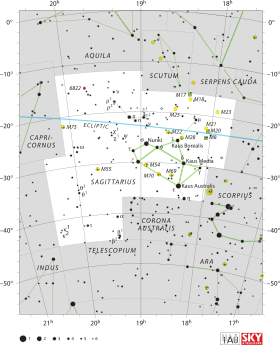Nu Sagittarii
The Bayer designation Nu Sagittarii (Nu Sgr, ν Sagittarii, ν Sgr) is shared by two star systems, ν¹ Sagittarii and ν² Sagittarii, in the constellation Sagittarius. The two stars are separated by 0.23° in the sky. Nu Sagittarii also has the traditional name Ain al Rami.
Nu Sagittarii is often cited as one of the earliest identified double stars. In the Almagest, Ptolemy describes the star as "nebulous and double", referring to the double nature of the star, as well as the nearby globular cluster NGC 6717.
ν¹ Sagittarii

|
| Observation data Epoch J2000.0 Equinox J2000.0 | |
|---|---|
| Constellation | Sagittarius |
| Right ascension | 18h 54m 10.2s |
| Declination | −22° 44′ 42″ |
| Apparent magnitude (V) | +4.86 |
| Distance | 1850 ± 900 ly (570 ± 270 pc) |
| Spectral type | G2/K1Ib/II + B9.2p[1] |
| Other designations | |
Nu¹ Sagittarii (Nu¹ Sgr, ν¹ Sagittarii, ν¹ Sgr) is a triple star system lying approximately 1850 light years from Earth. The primary component, Nu¹ Sagittarii A, is a spectral type K1 bright giant which has an apparent magnitude of +4.86. It is orbited by two magnitude +10.8 companions: Nu¹ Sagittarii B at a distance of 2.5 arcseconds from the primary, and Nu¹ Sagittarii C at a distance of 28.2 arcseconds.
ν² Sagittarii

|
| Observation data Epoch J2000.0 Equinox J2000.0 | |
|---|---|
| Constellation | Sagittarius |
| Right ascension | 18h 55m 07.1s |
| Declination | −22° 40′ 17″ |
| Apparent magnitude (V) | +5.00 |
| Distance | 270 ± 21 ly (83 ± 6 pc) |
| Spectral type | K3 II-III[2] |
| Other designations | |
Nu² Sagittarii (Nu² Sgr, ν² Sagittarii, ν² Sgr) is a spectral type K1 supergiant which has an apparent magnitude of +5.00. It is approximately 270 light years from Earth.
Name and etymology
- The name Ain al Rami is from the Arabic عين الرامي cain ar-rāmī meaning eye of the archer.[3]
- Both of ν stars, together with τ Sgr, ψ Sgr, ω Sgr, 60 Sgr and ζ Sgr were Al Udḥiyy, the Ostrich's Nest.[3]
References
- ↑ Parsons, Sidney B.; Ake, Thomas B. (1998). "Ultraviolet and Optical Studies of Binaries with Luminous Cool Primaries and Hot Companions. V. The Entire IUE Sample". The Astrophysical Journal Supplement Series. 119: 83. Bibcode:1998ApJS..119...83P. doi:10.1086/313152.
- ↑ Keenan, Philip C.; McNeil, Raymond C. (1989). "The Perkins catalog of revised MK types for the cooler stars". Astrophysical Journal Supplement Series. 71: 245. Bibcode:1989ApJS...71..245K. doi:10.1086/191373.
- 1 2 Allen, R. H. (1963). Star Names: Their Lore and Meaning (Reprint ed.). New York: Dover Publications Inc. p. 355. ISBN 0-486-21079-0. Retrieved 2012-09-04.